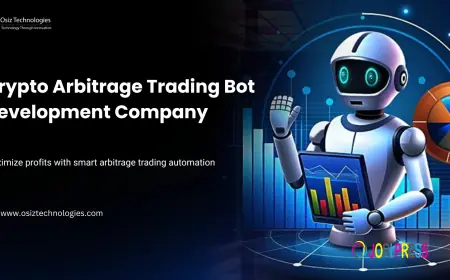AI Inference Market: Real-Time Intelligence Powering Tomorrow’s Technology
That statistic might surprise many who assume AI is all about training massive models. But in reality, it’s inference—the process of executing those models in real-time—that drives the most practical value across industries.

That statistic might surprise many who assume AI is all about training massive models. But in reality, it’s inference—the process of executing those models in real-time—that drives the most practical value across industries.From voice assistants to autonomous driving and predictive maintenance, AI inference is what makes intelligent systems work in the moment, and the global market is evolving fast to keep up.
Let’s explore the key advancements, real-world use cases, market trends, and ROI potential shaping this next-gen technology.
Understanding the Bottlenecks: What’s Holding AI Inference Back?
Despite its transformative power, AI inference hasn't been without challenges.
High Latency in Real-Time Systems
Traditional cloud-based inference introduces delays, especially in time-sensitive environments like healthcare or autonomous vehicles.
Hardware Limitations at the Edge
Edge devices, such as mobile phones or IoT sensors, often struggle to run complex models due to limited processing power and battery life.
Fragmented Toolchains & Integration
Businesses must juggle frameworks like TensorFlow, ONNX, PyTorch, and chipsets from NVIDIA, Qualcomm, Intel, etc., making integration messy and inefficient.
Cost-Intensive Infrastructure
Running inference workloads at scale can result in ballooning operational costs—especially for industries like e-commerce and surveillance that rely heavily on real-time insights.
How New Technologies Are Overcoming These Hurdles
Recent innovations in both hardware and software have significantly addressed AI inference inefficiencies.
Purpose-Built AI Inference Chips
Companies are developing dedicated AI inference processors optimized for low-latency, energy-efficient computing.
These chips are tailored to accelerate inference without wasting energy or compute resources.
Edge AI & On-Device Processing
With edge inference, AI models are deployed directly onto devices, eliminating the need to send data to the cloud.This drastically improves speed and protects user privacy—a major win for sectors like healthcare, retail, and smart homes.
Model Compression & Quantization
Smaller, faster models (using techniques like pruning and quantization) enable inference to run efficiently even on low-power devices, without significantly compromising accuracy.
Where AI Inference Is Already Making a Difference
AI inference is no longer theoretical—it’s driving real-world impact across multiple sectors.
Healthcare
Hospitals now use AI inference in real time for early stroke detection, tumor identification, and ICU monitoring.
Retail
Retailers like Amazon and Walmart use AI inference for fraud detection, dynamic pricing, and customer behavior analysis—all in real time.
Automotive
Self-driving cars depend on AI inference to identify objects, detect lanes, and react instantly to road conditions.
Companies like Tesla and Waymo integrate inference systems to make real-time driving decisions.
Manufacturing
Smart factories rely on AI inference for predictive maintenance, quality control, and defect detection—often preventing costly downtime before it happens.
Why Businesses Should Care: Key Benefits & ROI of AI Inference
If you’re a business leader, here’s why AI inference should be on your radar:
Real-Time Decision-Making
Inference enables on-the-spot intelligence, improving responsiveness across supply chains, customer service, and risk management.
Cost Optimization
Unlike cloud-based AI models, on-device inference cuts down on bandwidth and cloud fees, offering long-term cost efficiency.
Competitive Edge
Companies adopting AI inference can personalize customer experiences faster, detect fraud earlier, and optimize operations more effectively than slower, batch-based systems.
Scalability
Inference systems, once deployed, require minimal compute overhead, allowing businesses to scale solutions across hundreds or thousands of endpoints.
What’s Next? Emerging Trends in the AI Inference Market
The future of AI inference is packed with promise. Here's what’s coming next:
? Rise of TinyML
“Tiny Machine Learning” brings inference to ultra-low-power devices like sensors and microcontrollers. It’s opening new doors for AI at the edge in agriculture, logistics, and healthcare.
? Unified Software Platforms
Tech giants are investing in platforms that streamline deployment, regardless of the hardware—helping businesses avoid vendor lock-in and reduce integration friction.
? Federated Learning & On-Device Training
Inference isn't just running models anymore—it’s also helping update them in real time, without compromising data privacy.
Things to Consider Before Implementing AI Inference
Despite the benefits, businesses must weigh a few considerations:
Model Compatibility
Not all models can be deployed to the edge without significant rework. Compatibility with inference platforms is essential.
Security Risks
Running inference locally can introduce vulnerabilities—especially if deployed across a wide network of devices.
Upfront Hardware Costs
Though ROI is strong over time, initial investment in AI inference chips or edge devices may be high.
Final Thoughts: AI Inference Is the Next Competitive Frontier
In an era where real-time insight is king, AI inference has become the backbone of modern, intelligent systems.
Its ability to transform data into action on the fly is redefining what's possible across industries—from life-saving diagnostics to personalized shopping experiences.
What's Your Reaction?
 Like
0
Like
0
 Dislike
0
Dislike
0
 Love
0
Love
0
 Funny
0
Funny
0
 Angry
0
Angry
0
 Sad
0
Sad
0
 Wow
0
Wow
0

















































